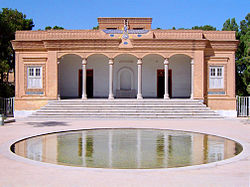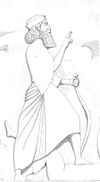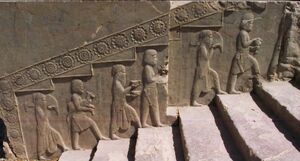| Part of a series on |
 Portal |
| Primary topics |
|
Zoroastrianism / Mazdaism |
| Angels and demons |
| Scripture and worship |
|
Avesta |
| Accounts and legends |
|
Dēnkard · Bundahišn |
| History and culture |
| Adherents |
|
Zoroastrians in Iran |
| See also |
| The examples and perspective in this article or section might have an extensive bias or disproportional coverage towards one or more specific regions. Please improve this article or discuss the issue on the talk page. |
Zoroastrians in Iran are the oldest religious community of the nation, with a long history continuing up to the present day. Prior to the Islamization in Iran, Zoroastrianism had been the primary religion of the Iranian people. And since the fall of the Sassanid Zoroastrian empire by the Arab conquest of Persia, Zoroastrians in Iran have faced much religious discrimination, including forced conversions, harassment , as well as being identified as najis and thus impure to some Muslims, making them unfit to live alongside Muslims, therefore forcing them to evacuate from cities and face major sanctions in all senses (See Persecution of Zoroastrians), although technically, Zoroastrians are protected as 'people of the book' in Islam.
Background[]

Zoroastrian Fire Temple in Yazd
Prophet Zoroaster and his first followers have been the proto-Indo-Iranians that lived between the Stone Age and Bronze Age (est. 1400-1200BC).[1] The proto-Indo-Iranians (Aryans) were later divided in to two distinct branches of Iranian and Indians; the Iranian branch migrated to Iran as early as 2000 BC.[2]
The time of the Iranian peoples' migration to Iran can be mainly estimated through Assyrian records.[3] Also, Herodotus (I, 101) had recalled one of the Mede tribes to be called "Magoi", better known as "Magis", a tribe known to have included many priests, who served both Medes and Persians. By the time of the Median empire (est. 612 BC), Zoroastrianism is known to have been well established in both Pars region (later capital of Persia) as well as in the Eastern regions.[4]
Achaemenid dynasty[]

Darius the Great
Persians led by Cyrus the Great soon established the second Iranian dynasty, and the first Persian empire by defeating the Medes dynasty in 549BC.[4] As Persians expanded their empire, Zoroastrianism was introduced to Greek historians such as Hermodorus, Hermippus, Xanthos, Eudoxus and Aristotle; each giving a different date regarding the life of Zoroaster but naturally believed him to be a Persian prophet and called him "Master of the magi"[5]
Although there are no inscriptions left from the time of Cyrus about his religion, the fire-altars found at Pasargadae, as well as the fact that he called his daughter Atossa, name of the queen of Vishtaspa (Zoroaster's royal patron), suggests that he indeed may have been a Zoroastrian.[5]
However, it is clear that by the time of Darius the Great (549 BC– 485/486 BC), the empire was clearly in favour of Zoroastrianism. Darius declares in one of his inscriptions that:
| “ | "A great God is Ahuramazda, who created this earth, who created yonder sky, who created man, who created happiness for man, who made Darius king, one king over many, one lord over many"[5] | ” |
Persepolis[]

Persepolis all nations staircase. Notice the people carrying Norouz gifts for the king
Persepolis (or Parsa) was one of the four capitals of the Achaemenid empire, built by Darius the Great and his son Xerxes; it was a glorious city known to the world as the "richest city under the sun". It was also the trading capital of the Near East.
One of the main functions of Persepolis was to serve as the host of the ancient Zoroastrian festival, Norouz. Therefore, every year representatives from each country under the rule of Persia would bring gifts to Persepolis to show their loyalty to the king and the empire.
Arsacid dynasty[]
|
|
This section requires expansion. |
Sassanid dynasty[]
The Sassanid dynasty was the first Persian empire which declared Zoroastrianism as the state religion and promoted the religion more than ever. It is believed that Avesta (a compilation of Zoroastrian sacred texts) was first gathered and put together at this time.
Prophet Mani[]
The prophet Mani was an Iranian of noble Parthian roots who established Manichaeism which contained many elements of Zoroastrianism as well as Gnosticism, however it saw the experience of life on earth by humans as miserable, which was a contrast to the Zoroastrian view which was to celebrate life through happiness.
Mani was received kindly by king Shapur I and spent many years at his court where he was protected during all of Shabuhr's reign. However Mani wrote in a semitic language and all his work had to be translated in to Middle Persian by his followers, who rendered the name of Mani's supreme god as Zurvan and called him the father of Ohrmazd[6] (Ahuramazda, God of Wisdom, main deity of Zoroastrianism).
Zurvanism[]
Although the origins of Zurvanite Zoroastrianism are unclear, it was during the Sassanid period that it gained widespread acceptance, and many of the Sassanid emperors were at least to some extent Zurvanites. Zurvanism enjoyed royal sanction during the Sassanid era but no traces of it remain beyond the 10th century.
Unlike Mazdean Zoroastrianism, Zurvanism considered Ahura Mazda not the transcendental Creator, but one of two equal-but-opposite divinities under the supremacy of Zurvan. The central Zurvanite belief made Ahura Mazda (Middle Persian: Ohrmuzd) and Angra Mainyu (Ahriman) twin brothers that had co-existed for all time.
Non-Zoroastrian accounts of typically Zurvanite beliefs were the first traces of Zoroastrianism to reach the west, which misled European scholars to conclude that Zoroastrianism was a dualist faith.
The Zoroastrian cult of Zurvan should not be confused with the Manichaeism's use of the name Zurvan in Middle Persian texts to represent the Manichean deity of light. Mani had himself introduced this practice (for perhaps political reasons) in his Shapurgan, which he dedicated to his patron Shapur II. For much of the rest of the Sassanid era, the Manichaens were a persecuted minority, and Mani was sentenced to death by Bahram I.
Calendar reforms[]
|
|
This section requires expansion. |
Sacred fires[]
The three great sacred fires of Persia at the time of the Sassanids were the Adur Farnbag, Adur Gushnasp and the Adur Burzen-Mihr which burnt in Pars, Media and Parthia respectively. Of these three the Adur Burzen-Mihr was the most sacred fire as it was linked to the prophet Zarathustra himself and king Vishtaspa.[7]
Mazdakite movement[]
Avesta[]
|
|
This section requires expansion. |
Arab conquest and Under the Caliphs empire[]
|
|
This section requires expansion. |
Mongol empire[]
The Mongol invasion of Iran resulted in tens of thousands of deaths and ruined many cities. Within half a century of the conquest, Ghazan Khan became a Muslim, which did not help the status of Zoroastrians in Iran. However, by the time that the Mongols were expelled, Pars province had escaped major damages and the Zoroastrians moved to the North of Pars mainly in the regions of Yazd and Kerman,[5] where even today the main Zoroastrian communities are found.
|
|
This section requires expansion. |
Safavid dynasty[]
|
|
This section requires expansion. |
Qajar dynasty[]

A Zoroastrian family in Qajar, Iran, circa 1910
During the Qajar Dynasty, religious persecution of the Zoroastrians was rampant. Due to the increasing contacts with influential Parsi philanthropists such as Maneckji Limji Hataria, many Zoroastrians left Iran for India. There, they formed the second major Indian Zoroastrian community known as the Iranis.
Modern history[]
| The neutrality of this section is disputed. Please see the discussion on the talk page. Please do not remove this message until the dispute is resolved. (December 2007) |
Pahlavi dynasty[]
Starting from the early twentieth century, Tehran, the nation's capital, experienced rapid migrations from all Iranian minorities. The Zoroastrian population increased from about 50 merchants in 1881 to 500 by 1912.[8]
During the reign of the Pahlavi dynasty, Zoroastrians changed from being one of the most persecuted minorities in Iran to a symbol of Iranian nationalism.[9] This notion carried on all the way through the 1979 Islamic revolution of Iran when Ayatollah Sadughi in defence of Zoroastrians[clarification needed] proclaimed that "We Muslims are like the branches of a tree, if our roots are cut off, we shall shrivel up and die", also the last prime minister before the revolution Shapour Bakhtiar held an anti-Khomeini meeting in Los Angeles on the day of the Zoroastrian Mehregan festival (1980), in tribute to "true nationalism"[9] (See Iranian nationalism).
Revolution[]
The Iranian revolution of 1979 and the eventual establishment of the new theocratic Islamic Republic posed many initial setbacks for religious minorities. Today, the Zoroastrian community in Iran is estimated by some to number some 22,000 - half the size of that in existence before the 1979 Islamic revolution.[{{fullurl:{{wikipedia:FULLPAGENAME}}}}#endnote_change]
Like the Armenian, Assyrian and Persian Jewish communities, Zoroastrians are officially recognized and on the grounds of the 1906 Constitution allocated one seat in the Iranian Parliament, currently held by Esfandiar Ekhtiari Kassnavieh.[10]
Important Zoroastrians in the 20th century:
- Jamshid Bahman Jamshidian also known as Arbob Jamshidi
- Dr. Farhang Mehr
- Keikhosrow Shahrokh also known as Arbob Keikhoshrow
See also[]
- Persian people
- Religious minorities in Iran
- Firooz Bahram Zoroastrian high school in Iran
References[]
Some or all of this article is forked from Wikipedia. The original article was at Zoroastrians in Iran. The list of authors can be seen in the page history.
- ↑ Mary Boyce "Zoroastrians, Their Religious Beliefs and Practices" pp. 1
- ↑ The Medes and the Persians, c.1500-559 from The Encyclopedia of World History Sixth Edition, Peter N. Stearns (general editor), © 2001 The Houghton Mifflin Company, at Bartleby.com.
- ↑ Mary Boyce "Zoroastrians, Their Religious Beliefs and Practices" Under the Achaemenians pp. 48
- ↑ 4.0 4.1 Mary Boyce "Zoroastrians, Their Religious Beliefs and Practices" pp. 49 Cite error: Invalid
<ref>tag; name "maryboyce49" defined multiple times with different content - ↑ 5.0 5.1 5.2 5.3 Mary Boyce, "Zoroastrians, Their Religious Beliefs and Practices": Under the Achamenians Cite error: Invalid
<ref>tag; name "maryboyce" defined multiple times with different content - ↑ Mary Boyce, "Zoroastrians, Their Religious Beliefs and Practices": Under the early Sassanians
- ↑ Mary Boyce, "Zoroastrians, Their Religious Beliefs and Practices": Under the mid Sassanid period
- ↑ Hukht (1973)
- ↑ 9.0 9.1 Janet Kestenberg Amighi "Zoroastrians of Iran, Conversion, Assimilation, or Persistence" pp. 143
- ↑ Press TV - Results for the minority MPs